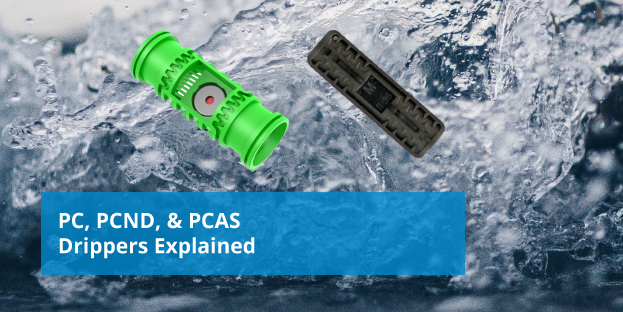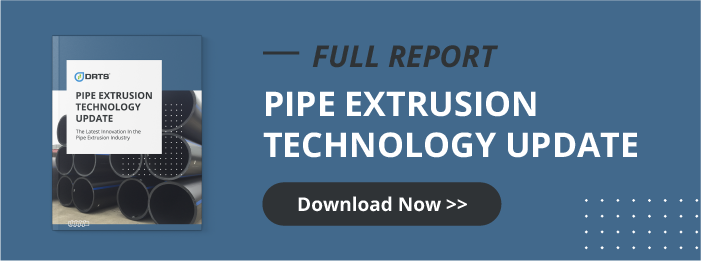In the drip irrigation world, drippers are king. There are a variety of types, flows, and niche application products to choose from. Depending on your application needs, choosing the right drip emitter is key yet there are many factors to consider in choosing the right dripper. In this post, we will be comparing 3 types of pressure compensating drippers commonly used in landscape and greenhouse irrigation: Pressure Compensating (PC) drippers, Pressure Compensating Anti-Siphon (PCAS) drippers, and Pressure Compensating Non-Drain (PCND) drippers.
What is the difference between PC, PCND, and PCAS drippers?
All three types of drippers are assembled from an injection molded dripper body as well as a rubber diaphragm and often with a cap to retain the diaphragm. The injection molded dripper body determines the flow rate of the dripper and the elastomeric diaphragm helps to regulate the flow of the dripper. In PCAS and PCND emitters, a valve is also created by the injection molded dripper against the diaphragm. The most common flow rates for all three types is 1, 2, and 4 liters per hour.
PC drippers provide a consistent flow rate over a pressure range typically starting from 0.6-1.0 bar and up to 3.5 bar pressure and higher. Variations in pressure can happen due to long pipe laterals losing pressure after each dripper and over the length of the pipe as well as due to elevation changes such as hills and valleys. Despite these pressure variations PC drippers will give a consistent flow rate as long as the pressure in the pipe remains in the operating range of the dripper. One drawback of pressure compensating drippers is that they allow water air or mud to flow back through the dripper and into the pipe under vacuum conditions.

PCAS drippers also provide a constant flow over an operating pressure range similar to PC drippers however PCAS drippers contain a check valve so that water, air, or mud can not flow backwards through the dripper even under vacuum conditions.
PCND drippers also contain a check valve preventing backflow similar to PCAS drippers however in addition they retain pressure in the pipe when the pressure source is turned off. The retention pressure of PCND drippers is typically 0.2 bar pressure.
When to Use Which Dripper?
This all depends on your application of course. PC emitters are most suitable for above ground irrigation where long laterals are used or if the system is installed on terrain with elevation changes which can vary the pressure. One meter of elevation increase will decrease the line pressure by 0.1 bar and vice versa. However when elevation changes are present and the system is shut off, most of the water in the line drains out of the lowest elevation drippers creating areas where more water is applied.
While water is draining out of the lowest drippers, air is sucked into the pipe through drippers at higher elevation due to the vacuum created by the water leaking out of the lower drippers. Note: this only happens when the pump is turned off so if watering only once per day or depending on the specific topography of the irrigated area the effects can often be negligible.
Best Applications for PCAS Drippers
PCAS drippers are most suitable for subsurface irrigation as the dripper labyrinth is protected from mud backflow into the dripper by the check valve. With the anti-siphon mechanism the lowest drip emitters in the system will still flow however more slowly as the higher elevation drippers cannot let in air, dirt or mud into the system to relieve the vacuum created. This means there may still be some problematic areas where higher flows occur during shut off of the system.
Best Applications for PCND Drippers
PCND drippers are most suitable for subsurface irrigation though they are often used above surface as well. PCND drippers have all the benefits of PC and PCAS drippers but perform more uniformly during shutdown of the system. Typically the pipe retains a pressure of 0.2 bar pressure which corresponds to a 2 meter column of water. This means that during shut-off the system will continue to run normally until the line pressure falls to 0.2 bar pressure at the lowest dripper in which case all the drippers will have stopped flowing and the water in the line does not drain out of the lowest point. This is ideal when irrigating many times a day such as is done in greenhouses with pulse irrigation or whenever higher flows at shut off are unwanted in lower elevation areas.
Get in Touch with a DRTS Expert
We hope this clears up things about PC, PCAS, and PCND drippers. If you have any further questions, you can request a free expert consultation to learn more about our drippers and what type you and your customers can benefit from most.
More from DRTS
3 Offline, Drip Irrigation QA Tests that Save Money, Time & Improve Quality
Converting your PE Production Line to a Drip Irrigation Line
5 Things to Consider When Choosing a Drip Irrigation Machinery Manufacturer






